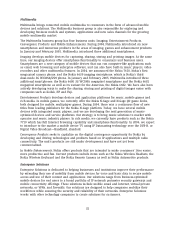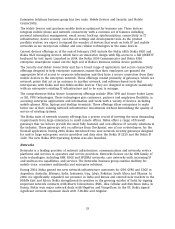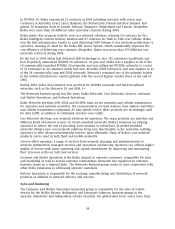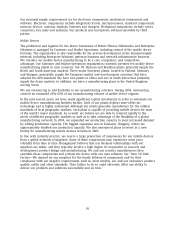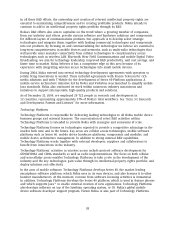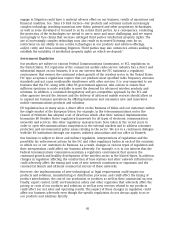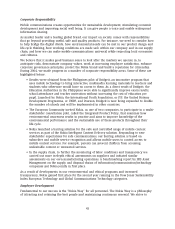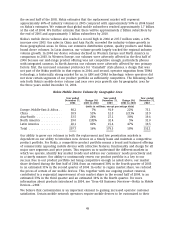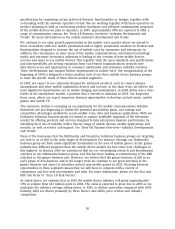Nokia 2004 Annual Report Download - page 42
Download and view the complete annual report
Please find page 42 of the 2004 Nokia annual report below. You can navigate through the pages in the report by either clicking on the pages listed below, or by using the keyword search tool below to find specific information within the annual report.Patents and Licenses
The detailed designs of our products are based primarily on our own research and development,
work and design and comply with all relevant public standards. We seek to safeguard our
investments in technology through adequate patent protection including design patents, trademark
registrations and copyrights that are used to protect proprietary features of our products. In 2004,
we filed new patent applications for more than 1 300 new inventions. Nokia is a holder of several
essential patents for various telecommunications standards. An essential patent covers a feature
that is incorporated into a public standard that all manufacturers are required to meet. In
accordance with the rules of standardization bodies such as the European Telecommunication
Standardization Institute, we are committed to promoting open standards by granting licenses on
a fair, reasonable and non-discriminatory basis. We have entered into several license agreements
with other companies relating to essential patents and other patents. Many of these agreements
are cross-license agreements with major telecommunications companies that cover broad product
areas and allow Nokia to choose its preferred product design. Despite the steps that we have taken
to protect our intellectual property rights, we cannot be certain that any rights or pending
applications will be granted or that the rights granted in connection with any future patents will
be sufficiently broad to protect our technology. Any patents that are granted to us may be
challenged, invalidated or circumvented, and any right granted under our patents may not
provide competitive advantages for Nokia.
In addition, with the introduction of new mobile data and other evolving technologies, such as
those enabling multimedia services, our products increasingly include complex technological
solutions that incorporate a variety of patented and proprietary technologies. A 3G mobile handset,
for example, may incorporate three times as many components, including substantially more
complex software, as our GSM phones. As the number of entrants in the market grows, as the
Nokia product range becomes more diversified, and as the complexity of the technology and the
overlap of product functionalities increase, the possibility of an infringement and related
intellectual property claim against us increases. The holders of patents relevant to our products
may be unknown to us or make it difficult for us to acquire licenses on commercially acceptable
terms. In addition, although we endeavor to ensure that companies that work with us possess
appropriate intellectual property rights, we cannot fully avoid risks of intellectual property rights
infringement created by suppliers of components and various layers in our products and solutions
or by companies with which we work in cooperative research and development activities.
Similarly, we and our customers may face claims of infringement in connection with our
customers’ use of our products and solutions. Finally, as all the technology standards, including
those used and relied on by us, include some intellectual property rights, we cannot fully avoid
risks of a claim for infringement of such rights due to our reliance on such standards. It is
therefore more likely that we will be required to obtain additional licenses or that some of the
components or layers in these handsets, or other products or solutions of ours, will be protected
by intellectual property rights of which we are unaware, potentially causing us to infringe the
rights of others.
The business models for mobile services have not yet been established in many aspects. The
unavailability of licenses for copyrighted content, delayed negotiations or restrictive copyright
licensing terms may have an adverse effect on the cost or timing of content-related services by us,
operators or third party service providers, and may also indirectly affect the sales of our handsets.
From time to time we are subject to patent claims from third parties. We believe that, based on
industry practice, any necessary licenses or rights under patents that we may require can be
obtained on terms that would not have a material adverse effect on our business, results of
operations or financial condition. Nevertheless, necessary licenses may not be available on
acceptable terms, if at all. The inability to obtain necessary licenses or other rights or the need to
41



